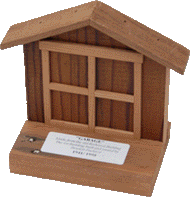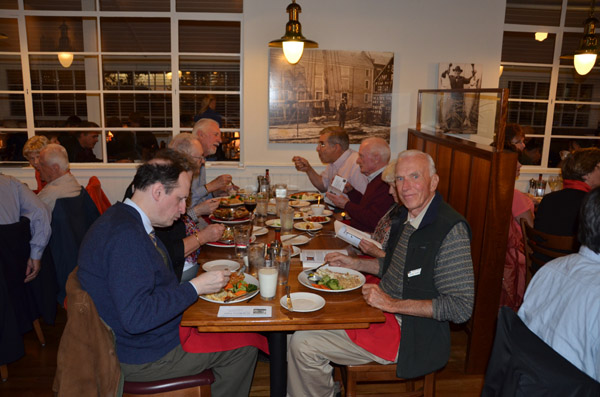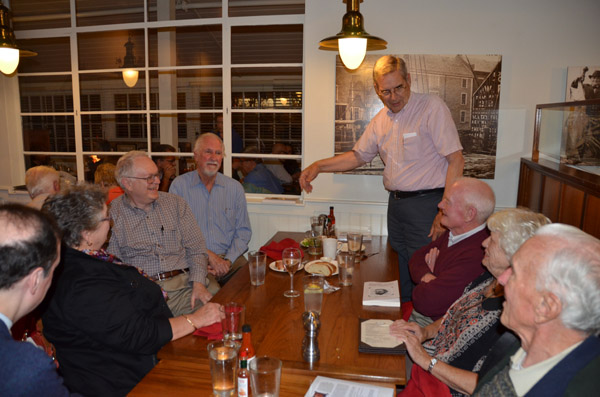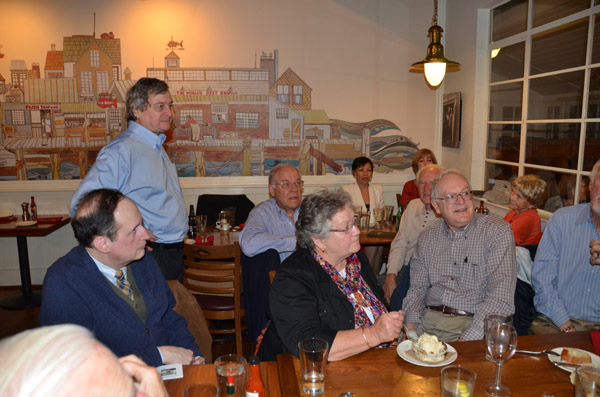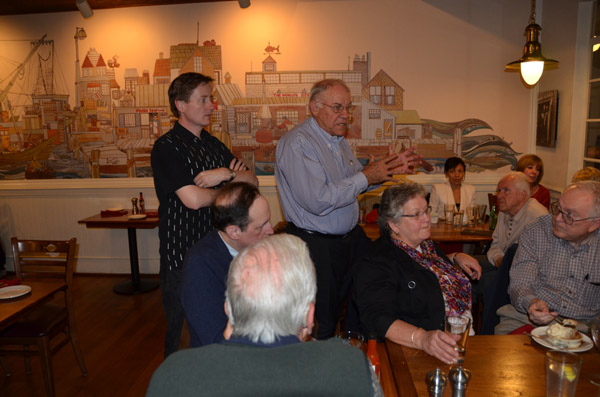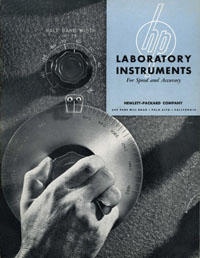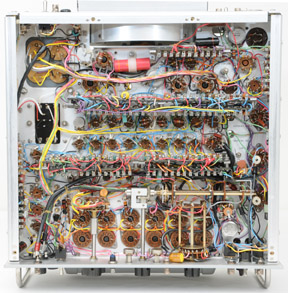2012, Another Vintage Year
To celebrate the end of 2012, here is a review of the most important events that occurred during this Great Vintage Year for the HP Memory Project. Without any attempt to make it logical, chronological or in rigorous sequence, the following listing has been built just for fun, mixing information of every kind, with the only objective to give you an overview of the various activities we have conducted during the year, for the evolution of the collection, and for the evolution of the overall project as well.
It should be noted that we continually seek to expand the Project, with contributions from any of you readers who feel a need to write for us your own story at HP. You should not feel hesitant to submit your memories of the wonderful work culture at HP, for those Golden Years of the last half of the 20th Century.
Meeting the Memoir Writers,
A visit to Palo Alto, in October, was the greatest event of the year. John Minck who had organized a celebration dinner, gave me the opportunity to meet almost all the HP retirees who have already contributed to the HP Memory Project with their written HP Memories. To make it more memorable, most of them were able to attend with their wives, who lived the same HP era by supporting their spouses in their high tech careers.
Move Mouse Cursor inside picture to pause
Another day in Palo Alto,
Another day in Palo Alto was an opportunity for a visit to Bob DeVries, who is still today, an engineer in his engineering environment... Bob's "Memories of a Hewlett Packard Product Designer" is another must read, HERE, on this website.
| John Minck (left) and Bob DeVries in his Lab at home in Palo Alto |
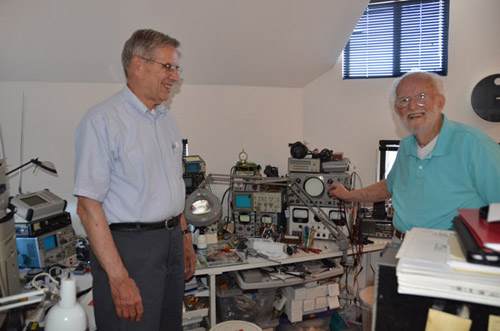 |
On the road path, from John's home to Bob's home... A must stop
| The HP Garage, 367 Addison Avenue, Palo Alto |
 |
And a visit to a REVOLUTION...
| The Computer History Museum in Mountain View |
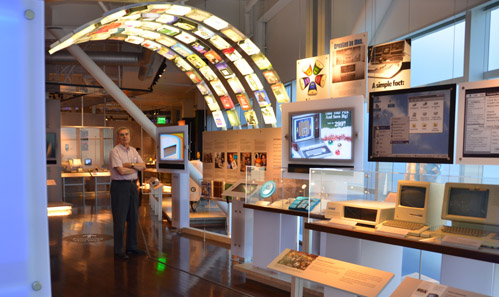 |
The Most Beautiful Gift of the Year
One more time, this year, the biggest contribution to the quality of the HP Memory Project archive, came from Glenn Robb. Glenn made the most beautiful gift the HP Memory Project could ever hope for. The very first catalog which was published by HP, in 1941 or 1942(?), nobody really knows what was the exact date of this edition. But for sure, it was the first, and it was unique in its content, including a lot of information about the state of the art electronic measurement technology of the time.
Products of the Year
Here are some previously missing important products which were added to the collection during 2012. Most of them were bought on ebay from American sellers, and as usual with American sellers, transaction was smooth, shipment was fast and highest care was taken by the seller to guarantee a safe crossing of the Atlantic.
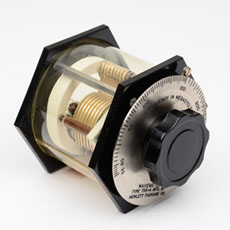 |
 The HP 758-A |
Unknown-Curiosity
I saw one for sale earlier on ebay two or three years ago, but the picture posted by the seller was of very poor quality, and this thing didn't appear in any HP catalog. But when this one appeared, this year, there was no more doubt; it was a Hewlett Packard product.
On a technical point of view, it's an absorption wavemeter, made of a tuning circuit and a small light bulb used as a tuning indicator. The surprising characteristic is the very large frequency range covered by the single tuning circuit - almost 3 octaves, from 55 to 400 MHz. The clever gimmick is that both the coil and the capacitor are tuned at the same time by a common axial command, in line with the tuning dial.
Now, what could had been the demanding market for such a tool? The most common usage of this kind of absorptive wavemeter is to quick-check the presence of harmonic or spurious radiations on medium power transmitters. The 758A design frequency range fits such a purpose when making this kind of checking on TV of FM transmitter. On the other hand, the look and feel, and the kind of material used in the manufacture of the 758A are typical of the 1940s, and beginning 1950s era. And it was in this period that the HP catalog included some instruments dedicated to the FM broadcast market, like the Model 335B Frequency Monitor & Modulation Meter, or the 325B Distortion Analyzer. But this is just a personal analysis and feeling. And any other, better informed source, will be welcomed. Contact Us.
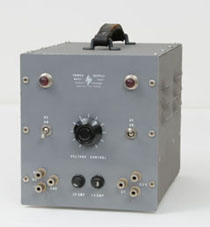 |
 The HP 710A Power Supply |
An HP 710A, First HP Power Supply
I was looking from a long time to find an HP 710A because it was the very first power supply manufactured by HP. It was introduced in the 1945 catalog, and by the way, it was the very last missing item in my reconstruction of the 1945 catalog, which can be seen, now completed, HERE.
The HP 710A played a role in one of the very rare vintage pictures of the HP early Lab history. Art Fong was out in the back parking lot with a demonstration vehicle radar system, with both Art and Bill Hewlett in the picture. Another fact which made the lack of a HP 710A an serious deficiency (in my mind) in the HP Memory collection.
By the way, the complete Art Fong story was also published on this website on April 2012. It is a must read HERE.
Parking lot demo of the vehicle radar,
with two HP 710A's on the bottom of the testing bench
Art Fong center, Bill Hewlett on his left, with coffee |
 |
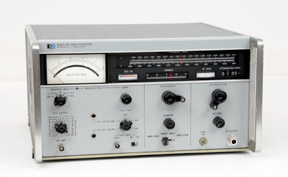 |
 The HP 3205A |
Another Story, Another Extra
Another instrument bought to illustrate a remarkable story was the HP 3205A, TELEMETRY - FM Signal Generator.
Zvonko Fazarinc, was one of those effective and illustrious scientists who labored for decades in the HP Labs environment.
To make a long story very short, the 3205A was the first instrument that Zvonko designed at HP in 1968. Having a problem with the signal generation section, based on the step-recovery diode frequency multiplier, Zvonko concluded that the only chance to solve the problem was to use a new tool that had not been tried before. Computer modeling came to mind but the available circuit analysis programs of the time were doing only steady state analysis. This excluded any non-linear circuits, which included the step-recovery diode case. The early HP 2116A minicomputer standing in the corner of the lab all of a sudden became the tool with which Zvonko solved his problem. Further evolutions of Zvonko's works on Electronic Computer Modeling are very well know today under the name of SPICE! The rest of Zvonko's fascinating memoir is published on this website HERE.
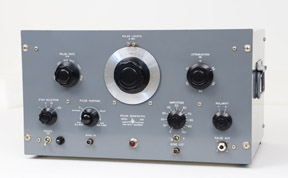 |
 The HP 212A |
Another Complement
to the 1950 Catalog
The HP 212A was the second pulse generator manufactured by Hewlett Packard after the 210A, already listed in the 1941 catalog, downloadable above.
The main interest of the HP 212A for the HP Memory Project resides in the fact that it was one of the very few instrument still missing to complete the collection with at least one of each item listed in the 1950 general catalog. The HP 212A pulse generator section used an unexpected block diagram, relying on a high power thyratron to charge a delay line and another thyratron to discharge the line after the user-set pulse width had occurred. These were high voltage pulsed, which could not be handled by ordinary vacuum tubes.
Our plan is to do the same kind of reconstruction we already did for the 1948 catalog, which is viewable HERE. This work, planned for 2013, will be a complement showing every instrument added to the 1948 production, and appearing in the 1950 catalog. For the archival purist, they were the following: HP 204A, portable audio generator - HP 404A, portable vacuum tube voltmeter - HP 400C, electronic voltmeter (replace the HP 400A) - HP 212A, pulse generator - HP 608A, VHF signal generator - HP 614A, UHF signal generator - HP 805, slotted line - HP 415A, standing wave indicator - HP 803A, VHF bridge - HP 417A, VHF detector - HP 360 series, low pass filters - HP 475A/B, tunable bolometers - HP 430A, microwave power meter - HP 100D, secondary frequency standard - HP 712A, power supply - HP 460A, wide band amplifier.
By this beginning of 2013, the only three instruments still missing to complete that job, and the collection, are: a HP 404A, portable vacuum tube voltmeter; a HP 100D, secondary frequency standard; and a HP 712A, power supply. If you heard of anyone of these for sale anywhere, please Contact Us !
Yes, you may call me obsessive.
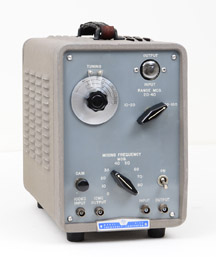 |
 The HP 512A |
A Companion for the HP 524A,
First Electronic Frequency Counter
Introduced in 1953, the HP 512A Frequency Converter is a companion for the HP 524A Frequency Counter. It extends the range of the 524A upward from 10 Mc to 100 Mc, and is also arranged to increase the sensitivity of the frequency counter for measurements between 100 kc and 10 Mc. It used the heterodyne downconversion method of scaling those RF frequencies.
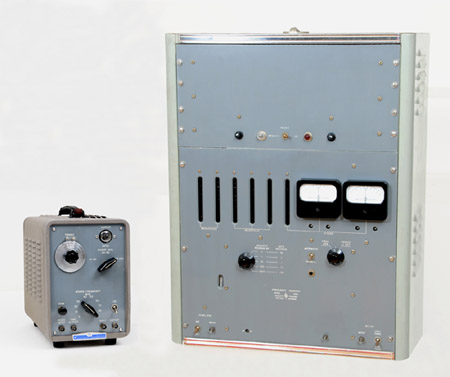 |
 The HP 524A (right) with its Companion HP 512A Frequency Converter
|
Two New Members for the Time Frequency Collection
Accessories for Improving the Accuracy of Frequency and Time Standards
To simplify measuring and monitoring of the performance of precision standard oscillators, and to increase the resolution with which intercomparison of local frequency standards and reference standards could be made, HP developed the Model 113BR, and 115BR Frequency Divider and Clock. The HP 113AR, predecessor of the HP 113BR shown below, was introduced and described in the November-December 1959 edition of the Hewlett Packard Journal.
These two devices are very symbolic of the Hewlett Packard leadership in frequency standard technology, which started by the beginning 1960s. One, or the other, was included in the rack of instrument, with a 5060A Cesium-beam Atomic Clock, which was transported around the world during the "Flying Clocks Campaigns". Different campaigns were conducted from 1964 to 1966, transporting the "flying clocks" to many of the world's timekeeping centers from the U.S.A. to Europe and Asia which finally achieved a world-wide time synchronization. The three most important of these campaigns were accurately reported in the Hewlett Packard Journals: July 1964 - April 1965, and August 1966. And many more information regarding the Hewlett Packard Time & Frequency Division are available on this website HERE.
 |
 The HP 115BR ---------------------------------------------- and -------------------------------------------- HP 113BR
|
And Another Vintage Frequency Counter
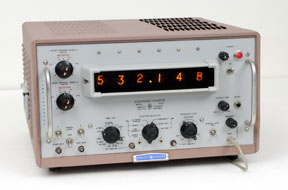 |
 The HP 523C |
The HP 523C was introduced in the 1959 catalog. It was the first of a category which came to named "Universal Counter" some years later. It's display in NIXIE numbers was a step ahead of the neon backlighted vertical numbers of the earlier HP 524A.
The Model 523C went well beyond the simple measurement of electronic signal frequencies, it easily measures period, time interval, phase delay, random events and ratios.
From a collector point of view, this counter was in a rarely seen in "Mint condition". The seller sent it to me in a package which included the original dust cover inside which the instrument probably spent its last fifty years. We seldom find a 50 year-old item in such a like new condition. It is worth the two inside view pictures shown below, which give, by the way, a good idea of the huge point-to-point wiring work required by the construction of vacuum tube logic circuits of that era.
 |
 The HP 414A |
The HP 414A Autoranging Voltmeter
While not really very useful today, nor much of a great collector showpiece, the main interest of this HP 414A "AutoVoltmeter," as it was introduced in the 1965 catalog, is told in an article published in MEASURE Magazine in September 1965.
The article, titled "A Product Goes to Market," is a very interesting description of the Marketing step by step process followed by the product from its design to its introduction at the 1965 Wescon Electronic Trade Show.
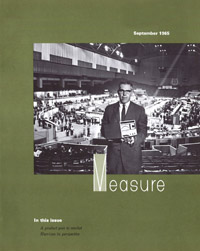 |
Cover of MEASURE Magazine - Sep. 1965
|
MEASURE Magazine September 1965
Click on link below for a PDF of the "A Product Goes to Market," four page article published in the September 1965 issue of MEASURE Magazine.
"A Product Goes to Market" - PDF File (3.3 Mb)
And to End the Year 2012 Vintage Product Listing, a fine Example of the Last Evolution of the Klystron Oscillator Technology
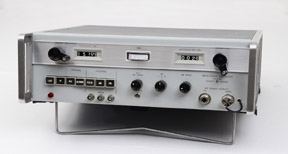 |
 The HP 8614A |
The HP 8614A UHF Signal Generator
The 8614A was described in the July 1963 edition of the Hewlett Packard Journal. It operates over the band from 800 to 2400 megacycles.
This generator is a perfect illustration of the mechanical complexity which was required to get the best possible performance of a Cavity Klystron Oscillator.
After its trip from California to France, it turned on at first power-up, and even more surprisingly, frequency and output power level were inside the original specifications. With a very honorable clean output signal, as shown below.
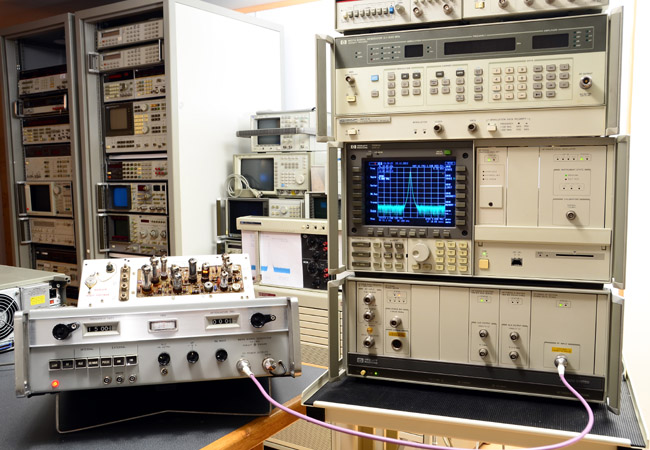 |
 The HP 8614A Working
|
Important Improvement of the Logic Analyzer Collection
Last but not least, working on the web version of Chuck House's logic analyzer story, we took the opportunity to enhance the collection with some essential items which have contributed to the success of this HP product line.
During the 1970s & 80s the Data Domain (Chuck House coined the term) was in ferment, with a maddening variety of IC and firmware technologies. The Birthing of Logic Analyzers plays out over a cast of fascinating personalities; of Chuck's management, his design customers, his technical mentor gurus, and his engineering team.
The result of this work, illustrated by almost every artifacts shown below, is a must read on this website:
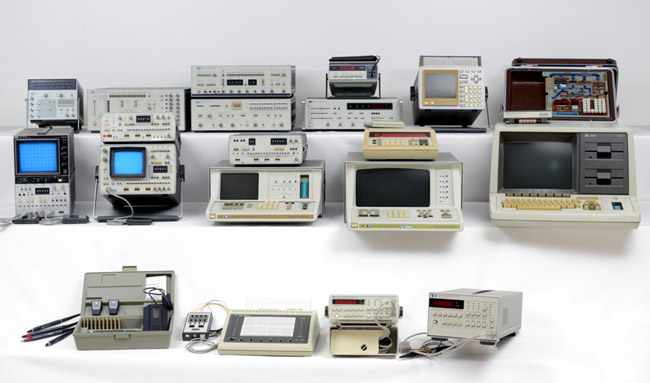 |
 Earliest Part of the Logic Analyzer Family in the HP Memory Collection
From the origins in the early 1970s to the beginning 1980s
|
That's it for 2012,
We will try to do better in 2013, and we wish you a great and happy new year !
|
|


